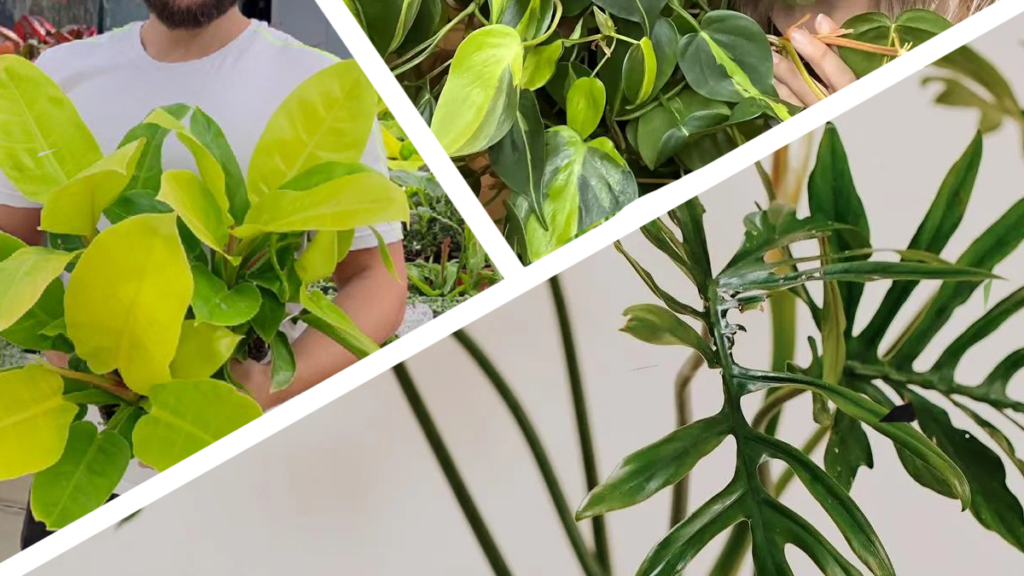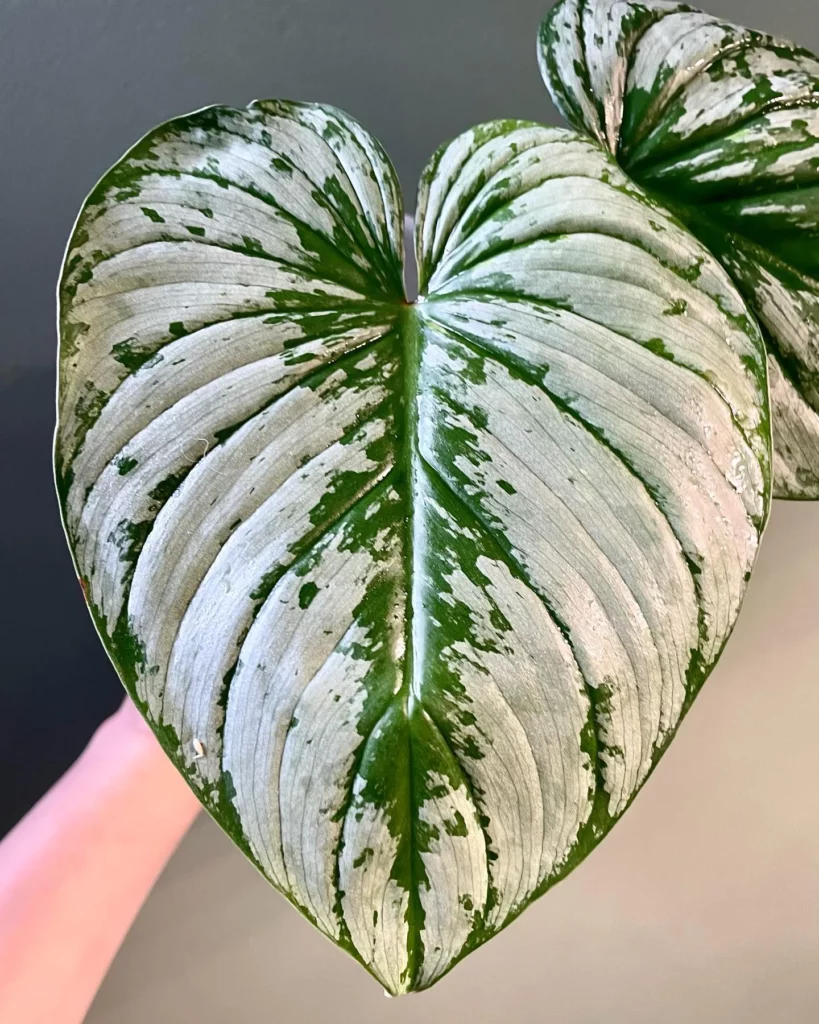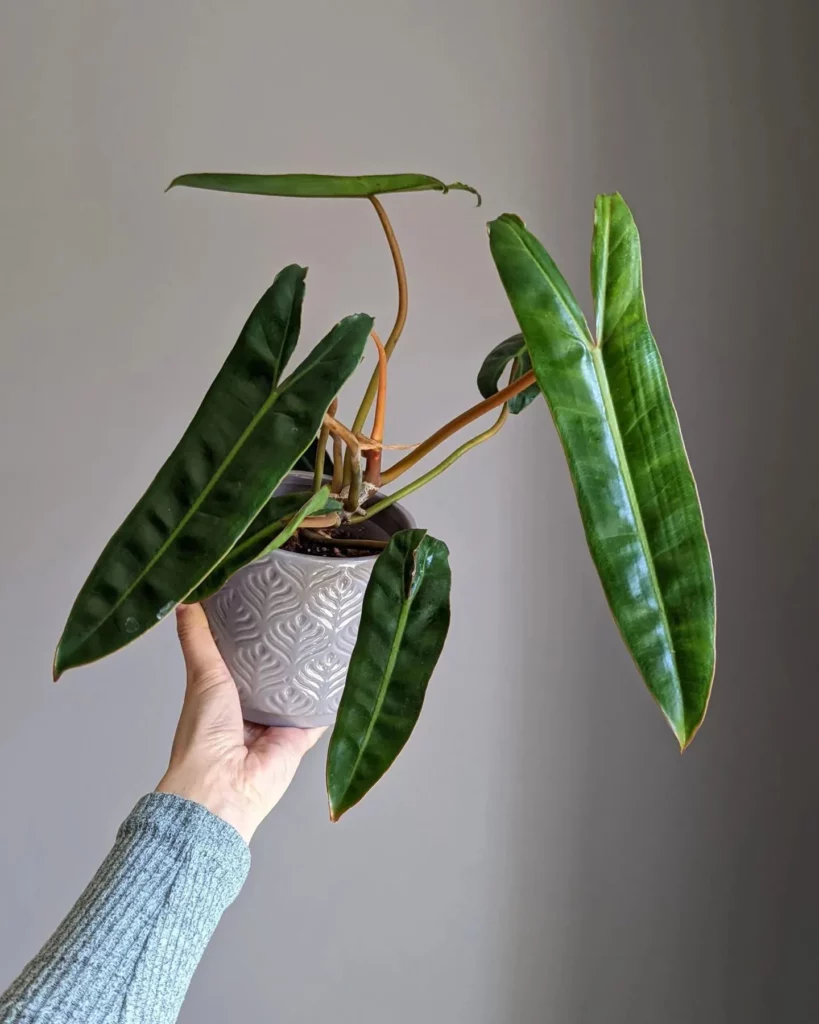The Philodendron Silver Queen is a stunning houseplant with its distinctive heart-shaped leaves. These leaves typically measure between 5-8 inches in length, making them a visually striking feature in any indoor space. One of the most captivating aspects of this plant is the upper surface of its leaves, which possesses a beautiful metallic sheen, giving them an iridescent look.
Key Takeaways:
- Learn how to care for your Philodendron Silver Queen with this ultimate guide.
- Discover the unique appearance of the Philodendron Silver Queen, including its heart-shaped leaves with a metallic sheen.
- Understand the light requirements of the Philodendron Silver Queen and how to provide the ideal conditions for its growth.
- Master the art of watering and fertilizing your Philodendron Silver Queen to ensure optimal health.
- Explore the growth and development of the Philodendron Silver Queen and learn how to manage its size and shape through pruning.
- Identify common pests and diseases that may affect your Philodendron Silver Queen and discover effective treatment methods.
Philodendron Silver Queen Appearance



The coloration of the Philodendron Silver Queen leaves is predominantly green, but they are adorned with scattered silver patches throughout. As these patches catch the light, they create a captivating play of colors and textures. When young, the leaves may have a reddish tint, adding an additional dimension of visual interest.
As for its size, the Philodendron Silver Queen has the potential to grow up to six feet tall with proper care and maintenance. Its robust foliage and impressive stature make it an excellent choice for those looking to introduce a bold statement piece into their indoor garden.
Philodendron Silver Queen Light Requirements



Proper lighting is essential for the health and growth of your Philodendron Silver Queen. This houseplant thrives in bright, indirect light, making it an ideal candidate for well-lit spaces in your home. While the Philodendron Silver Queen can tolerate lower light conditions, it may not reach its full potential in terms of growth and appearance.
Avoid placing your Philodendron Silver Queen in direct sunlight, as this can lead to leaf damage. Direct sunlight can cause the leaves to turn yellow or brown and may even scorch them. It’s important to strike a balance between providing enough light and protecting the plant from intense sunlight.
A great way to ensure your Philodendron Silver Queen gets the right amount of light is to place it near an east-facing window. This will allow the plant to receive bright, indirect light throughout the day without being subjected to harsh afternoon sun. If your windows receive intense sunlight, you can use a sheer curtain to filter the light. This will provide the plant with the ideal lighting conditions it needs to thrive.
Philodendron Silver Queen Watering



Proper watering is essential for the health and well-being of your Philodendron Silver Queen. Understanding the watering needs of your plant will help it thrive and maintain its vibrant appearance.
Water your Philodendron Silver Queen regularly, allowing the topsoil to slightly dry out between waterings. This plant prefers moist soil but is sensitive to over-watering. Over-watering can lead to root rot, which can be detrimental to the plant’s health.
On the other hand, under-watering can cause the leaves to dry out and turn yellow prematurely. It’s important to find the right balance when it comes to watering your Philodendron Silver Queen.
To determine when to water, insert your finger about an inch into the soil. If it feels dry at that depth, it’s time to water. However, if it still feels damp, it’s best to wait a little longer.
When watering, pour water into the soil until it starts to drain from the bottom of the pot. Be sure to empty any excess water that collects in the saucer, as the plant should not sit in standing water.
During the growing season, which is typically spring and summer, your Philodendron Silver Queen may require more frequent watering due to increased growth and higher temperatures. In contrast, during the dormant period in winter, reduce the frequency of watering as the plant’s water requirements decrease.
Philodendron Silver Queen Fertilizing



To promote the healthy growth of your Philodendron Silver Queen, it is essential to provide proper fertilization. Feed your plant with a balanced houseplant fertilizer once a month during the growing season. Dilute the fertilizer to half the recommended strength to prevent overfeeding.
Apply the diluted fertilizer to damp soil around the base of the plant. This helps to ensure that the nutrients are absorbed effectively. Avoid fertilizing during the winter months when the plant is in its dormant period.
Proper fertilization will help your Philodendron Silver Queen thrive and maintain its vibrant appearance. Remember to follow the recommended fertilizing frequency and give your plant the nutrients it needs to flourish.
Philodendron Silver Queen Potting


Proper potting is essential for the growth and health of your Philodendron Silver Queen. It is important to use well-draining potting soil that retains some moisture without becoming waterlogged. A good potting mix for your Philodendron Silver Queen should include a combination of peat moss or coir fiber, perlite or vermiculite, and organic matter such as compost or aged manure.
When repotting your Philodendron Silver Queen, choose a slightly larger pot to provide enough space for the roots to grow. Repotting every 2-3 years is recommended to prevent root binding and ensure the plant’s continued vitality.
Philodendron Silver Queen Propagation
If you want to expand your collection of Philodendron Silver Queen or share the beauty of this plant with friends and family, you’ll be glad to know that it can be easily propagated through stem cuttings or division.
Stem Cuttings
When taking stem cuttings for propagation, make sure you have a cutting that is at least four inches long and has at least one leaf node. The leaf node is where the new roots will form. Using clean and sharp scissors or pruning shears, make a clean cut just below a leaf node.
Once you have the cutting, you can dip the cut end in rooting hormone powder, which will help stimulate root growth. Then, plant the cutting in moist potting soil or a coco coir mix. Keep the soil moist but not overly wet to avoid rotting the cutting.
Place the pot in a warm and bright location, but avoid direct sunlight. A temperature between 70-80°F (21-27°C) is optimal for promoting root development. In a few weeks, you should see new roots forming, indicating successful propagation.
Division
Division is another method of propagating Philodendron Silver Queen. It can be done during repotting when the plant has become overcrowded or has produced multiple stems.
Gently remove the plant from its pot and carefully separate the small plants that have formed near the base. Ensure that each division has enough roots attached to grow independently. You can then repot the divided plants in separate containers using a well-draining potting mix.
Division not only allows you to propagate new plants but also helps avoid overcrowding, ensuring each plant has enough space to grow and thrive.
Philodendron Silver Queen propagation is an exciting way to expand your collection and share the beauty of this stunning plant. Whether you choose to propagate through stem cuttings or division, with a little patience and care, you can enjoy the growth and development of new Philodendron Silver Queen plants in no time.
Philodendron Silver Queen Growth and Development
Philodendron Silver Queen is a relatively fast-growing plant that can reach heights of up to six feet when given adequate support. With proper care, it can add a bold statement to your indoor garden. The Philodendron Silver Queen’s growth rate is impressive, making it an ideal choice for plant enthusiasts who desire a flourishing and visually striking plant.
To ensure optimal growth, provide your Philodendron Silver Queen with a stable support structure such as a trellis or moss pole. This will allow the plant to climb and reach its maximum height. Regularly monitor its growth and adjust the support accordingly to prevent the plant from toppling over or becoming unmanageable.
When it comes to size, the Philodendron Silver Queen can grow to be quite substantial. Its heart-shaped leaves can span up to 5-8 inches in length, creating a voluminous and lush appearance. The plant’s size and abundance of foliage make it a captivating centerpiece in any indoor space, adding a touch of natural beauty.
In order to maintain a desired size and shape, pruning is recommended. Trimming back overgrown or leggy stems will encourage bushier growth and help to keep the plant compact. Regularly removing yellow or damaged leaves will also promote healthy development and ensure the plant’s energy is directed towards new growth.
Philodendron Silver Queen Pests and Diseases
While the Philodendron Silver Queen is a resilient plant, it is not immune to common pests and diseases. Two common pests that can affect this beautiful houseplant are spider mites and mealybugs. Spider mites are tiny insects that thrive in dry conditions and can cause webbing on the leaves. Mealybugs, on the other hand, appear as small, white, cotton-like masses on the stems and leaves.
In addition to pests, Philodendron Silver Queen can also be susceptible to root rot if over-watered or exposed to overly wet conditions. Root rot is caused by fungi that thrive in overly moist soil, leading to the deterioration of the plant’s roots. This can result in wilting, yellowing leaves, and overall decline of the plant’s health.
To keep your Philodendron Silver Queen healthy, it is important to regularly inspect the plant for any signs of pests or diseases. Check the undersides of leaves for spider mites or look for the presence of mealybugs on the stems and leaves. If you notice any pests, you can try wiping them off with a damp cloth or using an insecticidal soap specifically formulated for houseplants.
To prevent root rot, ensure that you are watering your Philodendron Silver Queen correctly. Allow the topsoil to slightly dry out between waterings to avoid over-watering. Ensure there are proper drainage holes in the pot and avoid letting the plant sit in standing water. If root rot is already present, consider repotting the plant using fresh, well-draining soil and trimming away any affected roots.
FAQ
What is the appearance of Philodendron Silver Queen?
Philodendron Silver Queen has heart-shaped leaves that are about 5-8 inches long. The upper surface of the leaves has a beautiful metallic sheen, giving them an iridescent look. The leaves are green with silver patches scattered throughout. When young, the leaves may have a reddish tint. The plant can grow up to six feet tall.
What are the light requirements for Philodendron Silver Queen?
Philodendron Silver Queen thrives in bright, indirect light but can tolerate lower light conditions. Avoid placing it in direct sunlight, as this can damage the leaves and cause them to turn yellow or brown. A sheer curtain or placing the plant near an east-facing window is ideal for providing the right amount of light.
How often should I water Philodendron Silver Queen?
Water your Philodendron Silver Queen regularly, allowing the topsoil to slightly dry out between waterings. Over-watering can lead to root rot, while under-watering can cause the leaves to dry out and yellow prematurely. It’s important to find the right balance for optimal growth and health.
How often should I fertilize Philodendron Silver Queen?
Feed your Philodendron Silver Queen with a balanced houseplant fertilizer once a month during the growing season. Dilute the fertilizer to half the recommended strength and apply it to damp soil. Avoid fertilizing during the winter months when the plant is in its dormant period.
What type of potting soil should I use for Philodendron Silver Queen?
Use well-draining potting soil for your Philodendron Silver Queen that retains some moisture but doesn’t become waterlogged. A good potting mix consists of peat moss or coir fiber, perlite or vermiculite, and organic matter like compost or aged manure. Repot the plant every 2-3 years in a slightly larger pot to prevent root binding.
How can I propagate Philodendron Silver Queen?
Philodendron Silver Queen can be propagated through stem cuttings or division. For stem cuttings, take a cutting of at least four inches long with at least one leaf node. Dip the cut end in rooting hormone powder and plant it in moist potting soil or coco coir mix. Division can be done during repotting, separating small plants with enough roots attached to grow independently.
How tall can Philodendron Silver Queen grow?
Philodendron Silver Queen is a relatively fast-growing plant that can reach heights of up to six feet when given adequate support. With proper care, it can add a bold statement to your indoor garden. Pruning at appropriate intervals can help manage its size and maintain its shape.
What pests and diseases are common for Philodendron Silver Queen?
Philodendron Silver Queen is generally a resilient plant, but it can still be susceptible to common pests such as spider mites and mealybugs. It can also be affected by root rot if over-watered or exposed to excessively wet conditions. Regularly inspect your plant for any signs of pests or diseases and take appropriate measures to treat them.




